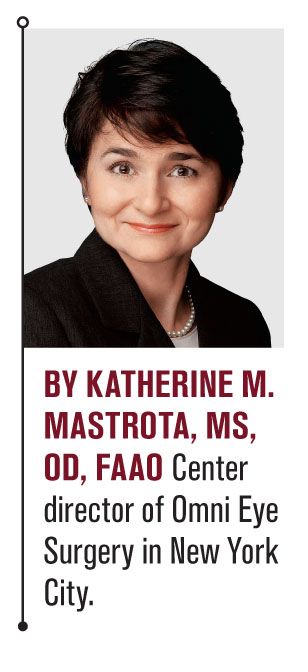Why you’re missing the dry eye right in front of you
A common barrier to many practitioners is the concern that their practice does not have the patient foundation to make investment in the services economically profitable. I assure you that OSD management will profit the patient in many ways that includes clearer, more comfortable vision, enhancing their productivity and overall wellbeing.

As we head into 2016, perhaps you are considering providing specialty services in dry eye or ocular surface disease (OSD) or eyelid care. A common barrier to many practitioners is the concern that their practice does not have the patient foundation to make investment in the services economically profitable. I assure you that OSD management will profit the patient in many ways that includes clearer, more comfortable vision, enhancing their productivity and overall wellbeing.
Related: The pros and cons of the latest dry eye technology
Patients at risk for dry eye
Who are the current patients in your practice that can benefit from your new OSD specialty? How can you identify them? Where can you find them? The following is my stream-of-consciousness brainstorm to help you recognize patients with or at-risk for ocular surface disease.
These patients include, but are not limited to all:
• Diabetic patients
• Glaucoma patients on topical or oral therapy
• Post-surgical patients (cataract, especially femto- assisted, glaucoma, ptergium, retina, plastics)
• Patients with sleep apnea or continuous positive airway pressure (CPAP) device users
• Patients with allergy, asthma, or atopic skin disease or dermatologic disease (especially rosacea)
• Patients who receive in-office intraocular injections (anti-vascular endothelial growth factor [VEGF])
• Patients with pseudoexfoliation
• Female patients in menopausal/peri-menopausal age range and those on hormone therapy
• Patients with arthritis or other autoimmune disease
• Patients who see another specialty provider for any chronic disease
• Patients with blepharitis, MGD, BMD
• Patients with any corneal disease
• Patients with recurrent “conjunctivitis” or patients who have had true conjunctivitis of any etiology
• Patients whose school or job demands include excessive computer or digital device use
• Patients who wear makeup
• Patients who wear contact lenses
• Patients who work for airlines, hospitals, hotels, or in any environmentally-controlled buildings (any building with dry heat or air conditioning), or in any old building with older heating, air conditioning or ventilation; have homes or offices with carpeting; or in the top 20 states for high allergen count
• Patients who cut grass, work around or use chemicals on a daily basis, or travel a good part of the time
• Patients with Parkinson’s disease
• Incomplete blinkers
More from Dr. Mastrota: The connection between dry eye and eyelashes
I hope you are starting to think that practically every patient you encounter is at risk for OSD. I am a firm believer that we all have some level of dry eye disease-we are only on different place in the path to symptomatic and life-altering disease.
Next: Tapping into this population
Tapping into this population
How do you tap into your patient population to help yourself and your patients?
• Detailed education of your staff
• Detailed educational brochure for your patients
• Detailed educational brochure for referring primary/specialty care doctors (especially endocrinologists, allergists, pediatricians)
• Questionnaire designed with specific questions about occupation, medication, health, and allergy available on your practice website and at check in with either Ocular Surface Disease Index (OSDI) or Standard Patient Evaluation of Eye Dryness (SPEED) or other verified dry eye screening tool
Related: How ODs can do better with dry eye
• Manual keratometry on all patients to observe the tear film/mire quality and topography to identify other irregularity
• Tear osmolarity testing on every patient as a baseline or screening
• If possible, digital ocular redness assessment, tear meniscus height, tear stability, lipid layer thickness, and meibography on every patient as a baseline/diagnostic test
• Eyelash rotation on every patient to identify and quantify demodex
• Eyelash photography as baseline documentation (Can you improve the health of the eyelashes? I believe you can)
• I recommend office-based lid and lid margin microblepharoexfoliation to every patient after photo documentation and explanation of blepharitis and its sequelae
Blog: Dry eye should remain in the hands of ECPs
In addition to the aforementioned benefits of attention and treatment of OSD, you and your patients’ efforts will help ensure successful ocular surgery (including injections) with better pre-operative data and infection risk reduction. Aesthetics will be improved. Contact lenses will be worn longer. And you will have happier patients.
Offer lid hygiene products, omega supplements, and occlusion products (such as eye masks, specialty eyewear, and CPAP eye protection) in your office.
Go forth, educate, and treat.
Newsletter
Want more insights like this? Subscribe to Optometry Times and get clinical pearls and practice tips delivered straight to your inbox.